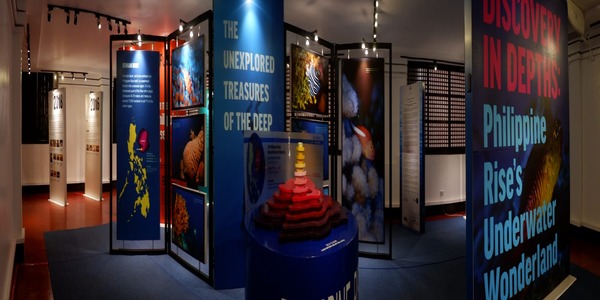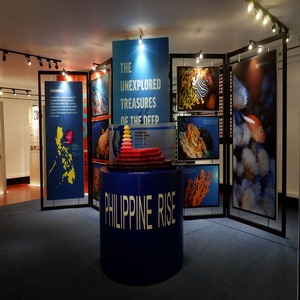| ‹ | The Journey Towards the Protection of Philippine Rise |
› |
|---|
The exhibition “The Journey Towards the Protection of Philippine Rise” was opened on February 19, 2019 in time for the centenary celebration of Marinduque as an independent province. It features underwater photos, maps and a video of the Benham Bank taken by a team of marine scientists, researchers, technical divers and videographers from Oceana, Bureau of Fisheries and Aquatic Resources (BFAR), University of the Philippines Marine Science Institute, (UP-MSI) UP Los Baños School of Environmental Science and Management, UPLB Institute of Biological Sciences, Philippine Navy and Philippine Coast Guard in an exploration on May 2016.
The Philippine Rise is approximately 24 million-hectare undersea region on the east of Luzon. It includes a 13.4 million-hectare outer section that was validated by the United Nations Commission on the Limits of the Continental Shelf as part of the Philippine territory in 2012. It is about 3,000 to 3,500 meters deep covering the vast coasts off as far as Cagayan to Catanduanes provinces.
Larger than Luzon, Philippine Rise is a home to rare corals (some have a lifespan of 900 years) and hundreds of species of marine creatures. Its diverse ecosystem attracts and serves as a spawning ground and nursery of migratory fishes like the highly-valuable Pacific bluefin tuna, which are known to swim to the US and Mexico.
Formerly known as the Benham Rise, the Philippine Rise was discovered in 1933 by American Surveyor Andrew Ellicott Kennedy Benham. In May 2017, Benham Rise was renamed Philippine Rise in exercise of our sovereign rights and jurisdiction.
In May 2018, the 352,390 hectares, a portion of the Philippine Rise was proclaimed as Philippine Rise Marine Resource Reserve and 49,684 hectares was declared as a Strict Protection Zone within the reserve or area for actual ground survey and delineation for only Filipino scientists and the remaining areas within the PRMRR are collectively designated as Special Fisheries Management Area.
At the center of this protected zone is the Benham Bank, the shallowest portion of the seamount with a depth of 40-70 meters and measures 17,000 hectares.
The exhibition was donated to the Filipino people by Oceana Philippines in February 2019 and was first displayed at the National Museum of Natural History in 2019 which aims to raise awareness and to inspire Filipinos to conserve and protect our seas.
The Journey Towards the Protection of Philippine Rise is an exhibit in the National Museum Marinduque-Romblon that highlights the natural and cultural significance of the Philippine Rise, a vast undersea region located east of Luzon, Philippines.
The exhibit features interactive displays, multimedia presentations, and information panels that showcase the rich biodiversity and unique geological features of the Philippine Rise. It also presents the efforts and initiatives undertaken by various organizations and institutions to study and protect this important marine ecosystem.
Aside from its natural significance, the exhibit also emphasizes the cultural importance of the Philippine Rise to the indigenous communities in the area. It features information about the traditional knowledge and practices of the local communities, as well as their efforts to promote sustainable fishing and conservation.
The Journey Towards the Protection of Philippine Rise is known for its comprehensive and informative presentation of the Philippine Rise and its significance to the Philippines. It aims to raise awareness about the importance of protecting this unique marine ecosystem and promoting sustainable development in the area.


